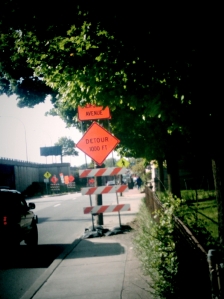This blog post is the result of an idea that sparked at a conversation over a wine glass during the happy hour that followed the Organizing 2.0 meeting in W.PA. (The hour became hours and the last discussion group broke apart around 1 am in the morning).
It all started as a debate on how a proper campaign should be organized. The canvasser shall go door to door and discuss the specific issues each community member does have and build around that. It is not an yes or no type of questionnaire because the canvasser needs to understand the community beyond statistics and appearances in order to provide the campaign organizer with the information that will be used later to build a platform for a specific candidate. Now, that is exactly what I learned about ten years ago from the British women, the political leaders teaching us –young women and potential political workers from East Europe. Yet, two weeks ago, at the discussion table I looked contradicted.
No, I was saying, you already have an ideology and you need to identify those specific issues that are relevant for it – even more you need to identify the specific community members who already understand the benefits of the particular solution you suggest for these particular sets of issues. Because you need to build relationships with these people and you need to invest in their leadership qualities as they will be the ones promoting the solution… But I was no longer looking at community organizing as a political campaign organizer, but as a social marketer.
As a political campaign organizer you are selling a person to voters – a political candidate. What we want to know is what his potential voters need and expect from a legislator. After you will help to build a platform that answers their specific needs and the third step is to return to the community in question to show people how this platform will answer their needs and meet their expectations. So do not blame politicians for failing you after elected. First , these specific community needs will change as population ages , economic conditions change , the civil issues at hand do change…And so will a politician’s platform.
Plus when you sell a political leader the currency is votes – someone’s specific need may be ignored if a majority support is not perceived. For example let’s take what Republicans learned about Medicare – you can mess with universal, government funded health insurance as long as you do not mess with the universal, government funded insurance of your electorate. Even if your electorate seems to be unable to comprehend that they are benefiting from a universal, government funded health insurance plan when opposing its general counterpart. A politician will only address an issue as long as it will not lead to a dramatic loss of votes. [1]
As a social marketer you already know the solution. Most times the solution is supported by significant professional research, you just need to sell this solution to community members when they grew (up) used to belief the solution is fundamentally different. For example , when selling “transit” as a solution for transportation issues such as transportation funding, congestion, travel time, pricing, economic value and so on you may need to address first your target population’s belief that the above issues are always solved by a free market car industry and by increasing mobility. [2]
It is not much different from selling them an energy efficient washing machine to solve their electric bill issue. It is just harder because you need to reach a deeper level – you need to change what a person believes. When selling energy efficient washing machines all you need is to convince that the model you are selling will save them enough on the electric bill to be worth the higher price tag. Because your customer already believes that the solution to his/her electric bill issue will be an energy efficient washing machine. He may doubt that the particular model you are selling does consume a lot less electric and thus it can effectively solve his issue. What you change is this person’s Attitude. When selling transit to Pittsburgh residents as a way to improve travel time and reduce congestion, you must change their Belief that the solution will always be better mobility when in fact is better access.
Notes:
[1] There are exceptions but those are few and far in-between
[2] This explains why is so much harder to sell transit in the United States.

